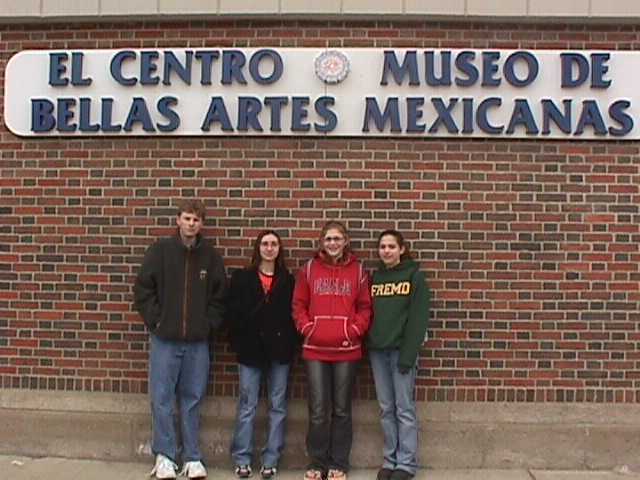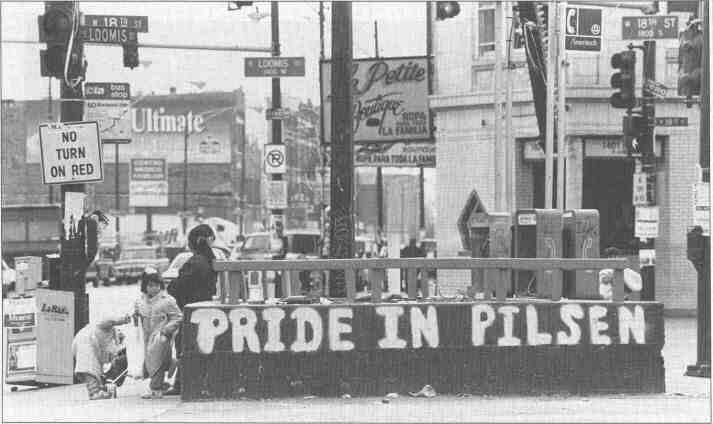Life in Pilsen
(from trap to attraction)
"And then she made me stand up on a box of books and point. That one? she said, pointing to a row of ugly three-flats, the ones even the raggedy men are shamed to go into. Yes, I nodded even though I knew that wasn't my house and started to cry." (1)
"Marin says that if she stays here next year, she's going to get a real job downtown because that's where the best jobs are, since you always get to look beautiful and get to wear nice clothes and can meet someone in the subway who might marry you and take you to live in a big house far away." (1)
"Friends and neighbors will say, What happened to that Esperanza? Where did she go with all those books and paper? Why did she march so far away?
"They will not know I have gone far away to come back. For the ones I left behind. For the one who cannot out." (1)
In The House on Mango Street, Esperanza and her peers view Pilsen and its inhabitants as disreputable objects which they desperately need to get away from. Pilsen is viewed as a slum filled with derelicts and potential thieves, the houses are all falling apart, and no decent opportunites await anyone who exists within this realm of filth. The novel centralizes around the theme of Esperanza constantly wishing to escape from this place and purify herself of any traces that may linger upon her once her escape is effectively made, and her reconciliation to the fact that despite all the ugly horrors of this area, it will forever be a part of her.
 Today, children see ethnic neighborhoods in much different lights than Esperanza did. The ethnic tensions which once discouraged residents from venturing into other neighborhoods have since cooled, and often school groups now venture into other neighborhoods to understand the unique diversity which is the very foundation of Chicago. A group of children from a predominantly European neighborhood ventured into a variety of these neighborhoods which differed quite dramatically from their own neighborhood. While they did not venture into Pilsen, their reactions to another Mexican American community are still an accurate tool to compare how Pilsen is viewed now. The simple fact that a group of suburban third graders was encouraged to venture into a Chicago ethnic neighborhood is proof enough that things have changed since the times when Pilsen was a place being overrun by "the wrong kind of people," a place for the white community on the outside to avoid and for the white community on the inside to flee from. Now, the diversity of Chicago's many neighborhoods is looked at as something to be embraced, leading to a more whitewashed image for Pilsen, stressing community and culture over poverty and inequity.
Today, children see ethnic neighborhoods in much different lights than Esperanza did. The ethnic tensions which once discouraged residents from venturing into other neighborhoods have since cooled, and often school groups now venture into other neighborhoods to understand the unique diversity which is the very foundation of Chicago. A group of children from a predominantly European neighborhood ventured into a variety of these neighborhoods which differed quite dramatically from their own neighborhood. While they did not venture into Pilsen, their reactions to another Mexican American community are still an accurate tool to compare how Pilsen is viewed now. The simple fact that a group of suburban third graders was encouraged to venture into a Chicago ethnic neighborhood is proof enough that things have changed since the times when Pilsen was a place being overrun by "the wrong kind of people," a place for the white community on the outside to avoid and for the white community on the inside to flee from. Now, the diversity of Chicago's many neighborhoods is looked at as something to be embraced, leading to a more whitewashed image for Pilsen, stressing community and culture over poverty and inequity.
 Certainly, in Pilsen "the noise of street gangs [still] often competes with the rumbling of the Red Line El train that stops at 18th Street," (9) but when Pilsen is discussed today, the focus is on the more positive aspects: the murals, "visible from the minute passengers disembark from the El at the 18th Street Blue Lint El stop;" (9) the Mexican Fine Arts Center Museum, one of the integral elements in providing a link between Pilsen's Hispanic community, Mexico and the rest of Chicago; the colorful restaurants, markets and cultural centers that blend Mexican and Latin American cultures with mainstream America and even the remnants of Czech and Slavic influence left over from the days before Pilsen was one of the nation's largest Latino communities. The large number of recent immigrants (not just from Mexico but from many other Latin American countries) means that not every resident of Pilsen can even speak English. These newcomers, who help in maintaining Pilsen's cultural independence, combine with a wide variety of other kinds of people--second- and third-generation immigrants, biracial people, and yes, individuals of non-Hispanic ethnicities--a diversity within the already-established diversity of one of the city's primary "ethnic neighborhoods."
Certainly, in Pilsen "the noise of street gangs [still] often competes with the rumbling of the Red Line El train that stops at 18th Street," (9) but when Pilsen is discussed today, the focus is on the more positive aspects: the murals, "visible from the minute passengers disembark from the El at the 18th Street Blue Lint El stop;" (9) the Mexican Fine Arts Center Museum, one of the integral elements in providing a link between Pilsen's Hispanic community, Mexico and the rest of Chicago; the colorful restaurants, markets and cultural centers that blend Mexican and Latin American cultures with mainstream America and even the remnants of Czech and Slavic influence left over from the days before Pilsen was one of the nation's largest Latino communities. The large number of recent immigrants (not just from Mexico but from many other Latin American countries) means that not every resident of Pilsen can even speak English. These newcomers, who help in maintaining Pilsen's cultural independence, combine with a wide variety of other kinds of people--second- and third-generation immigrants, biracial people, and yes, individuals of non-Hispanic ethnicities--a diversity within the already-established diversity of one of the city's primary "ethnic neighborhoods."
Not everyone prefers this overt focus on the "positive side" of Pilsen; today some residents complain that efforts to change the district from a neighborhood through and through--with all of its imperfections and rough edges intact--into something approaching a tourist attraction is taking away the soul of the neighborhood, that such an effort goes against the principles and beliefs of the struggle that made Pilsen what it is in the first place. The truth, however, is somewhere in-between. The amalgamation of the two sides of Pilsen: the stained-glass version of ethnic, cultural Pilsen and the wild nature that once made everyone fear this neighborhood, can be combined to give a realistic image of the actual Pilsen that exists today.
"No, Alicia says. Like it or not you are Mango Street, and one day you'll come back too." (1)

* Museum image: Students from the William Fremd High School Spanish Club, photographed in front of the Mexican Fine Arts Museum in November 2003. Fremd Spanish Club. Online. 4/17/2004.
* El stop image: Askallie, Lillie and Wailin Wong. Welcome to Pilsen. Chicago's Ethnic Neighborhoods, 2000. Medill School of Journalism, Northwestern University. Online. 3/6/2004.
* Loomis St. image: Illinois Issues, December 26, 1994. Photo by Richard Foertsch.
Home
 Today, children see ethnic neighborhoods in much different lights than Esperanza did. The ethnic tensions which once discouraged residents from venturing into other neighborhoods have since cooled, and often school groups now venture into other neighborhoods to understand the unique diversity which is the very foundation of Chicago. A group of children from a predominantly European neighborhood ventured into a variety of these neighborhoods which differed quite dramatically from their own neighborhood. While they did not venture into Pilsen, their reactions to another Mexican American community are still an accurate tool to compare how Pilsen is viewed now. The simple fact that a group of suburban third graders was encouraged to venture into a Chicago ethnic neighborhood is proof enough that things have changed since the times when Pilsen was a place being overrun by "the wrong kind of people," a place for the white community on the outside to avoid and for the white community on the inside to flee from. Now, the diversity of Chicago's many neighborhoods is looked at as something to be embraced, leading to a more whitewashed image for Pilsen, stressing community and culture over poverty and inequity.
Today, children see ethnic neighborhoods in much different lights than Esperanza did. The ethnic tensions which once discouraged residents from venturing into other neighborhoods have since cooled, and often school groups now venture into other neighborhoods to understand the unique diversity which is the very foundation of Chicago. A group of children from a predominantly European neighborhood ventured into a variety of these neighborhoods which differed quite dramatically from their own neighborhood. While they did not venture into Pilsen, their reactions to another Mexican American community are still an accurate tool to compare how Pilsen is viewed now. The simple fact that a group of suburban third graders was encouraged to venture into a Chicago ethnic neighborhood is proof enough that things have changed since the times when Pilsen was a place being overrun by "the wrong kind of people," a place for the white community on the outside to avoid and for the white community on the inside to flee from. Now, the diversity of Chicago's many neighborhoods is looked at as something to be embraced, leading to a more whitewashed image for Pilsen, stressing community and culture over poverty and inequity. Certainly, in Pilsen "the noise of street gangs [still] often competes with the rumbling of the Red Line El train that stops at 18th Street," (
Certainly, in Pilsen "the noise of street gangs [still] often competes with the rumbling of the Red Line El train that stops at 18th Street," (